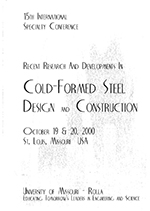Session Dates
19 Oct 2000
Abstract
Experiments show that, after ultimate load, sheeting may fail by three distinct post-failure modes. In this paper, three finite element models are presented, one for each post-failure mode. One of the finite element models was difficult to develop. A spring model explains this. The finite element models show that, at ultimate load, only two different ultimate failure modes exist. This is important for the development of mechanical models for sheeting failure.
Department(s)
Civil, Architectural and Environmental Engineering
Research Center/Lab(s)
Wei-Wen Yu Center for Cold-Formed Steel Structures
Meeting Name
15th International Specialty Conference on Cold-Formed Steel Structures
Publisher
University of Missouri--Rolla
Document Version
Final Version
Rights
© 2000 University of Missouri--Rolla, All rights reserved.
Document Type
Article - Conference proceedings
File Type
text
Language
English
Recommended Citation
Kerstens, Jan; Snijder, Bert; Bakker, Monique; and Hofmeyer, H., "FE Models for Sheeting under Interaction Load" (2000). CCFSS Proceedings of International Specialty Conference on Cold-Formed Steel Structures (1971 - 2018). 2.
https://scholarsmine.mst.edu/isccss/15iccfss/15iccfss-session2/2
FE Models for Sheeting under Interaction Load
Experiments show that, after ultimate load, sheeting may fail by three distinct post-failure modes. In this paper, three finite element models are presented, one for each post-failure mode. One of the finite element models was difficult to develop. A spring model explains this. The finite element models show that, at ultimate load, only two different ultimate failure modes exist. This is important for the development of mechanical models for sheeting failure.



